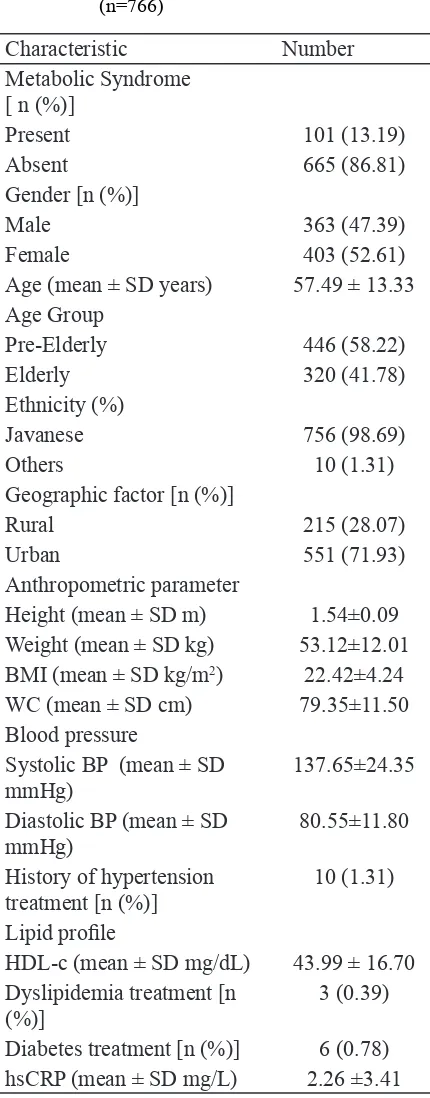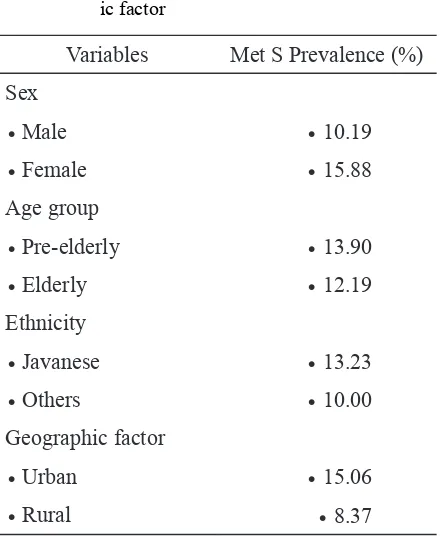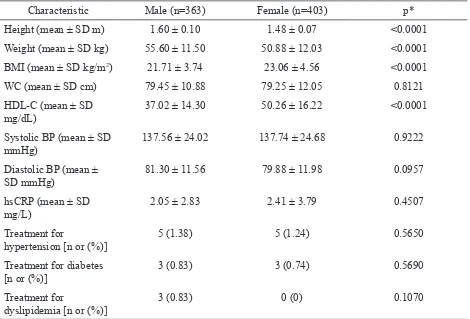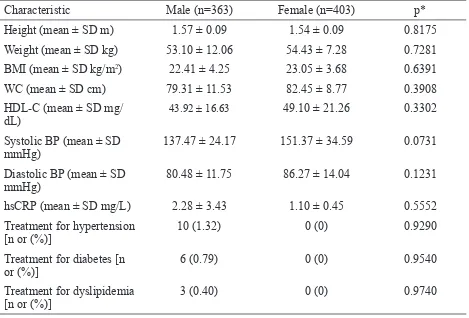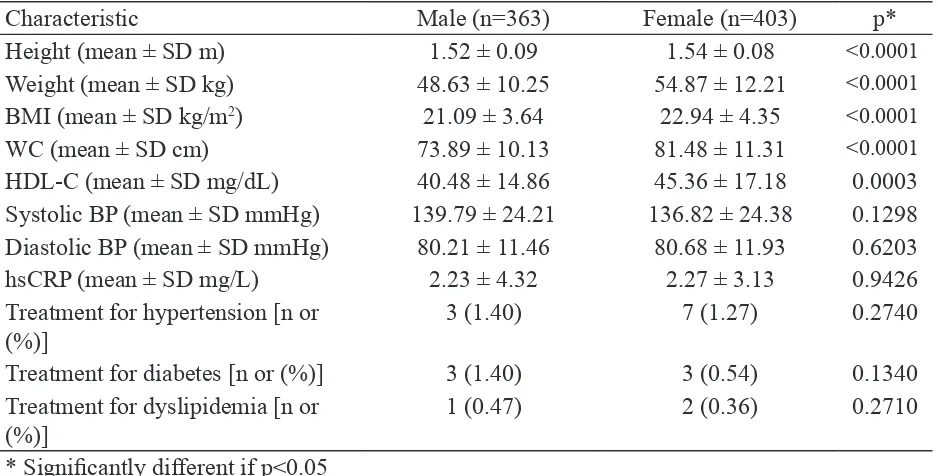Corresponding author: osmansianipar@ugm.ac.id
Prevalence of metabolic syndrome and
its components based on International
Diabetes Federation (IDF) definition in
Yogyakarta Special Region, Indonesia
Choo Hao Jian1, Fatwa Sari Tetra Dewi2, Elizabeth Henny Herningtyas3*
1Undergraduate Program of Medicine, 2Department of Public Health, 3Department of
Clinical Pathology and Laboratory Medicine, Faculty of Medicine, Universitas Gadjah Mada, Yogyakarta
DOI: http://dx.doi.org/10.19106/JMedSci00403201705
ABSTRACT
Metabolic syndrome (MetS) is a group of risk factors which increase morbidity and mortality for cardiovascular disease and diabetes. The prevalence of MetS has been on the rise. No previous study has described the prevalence of MetS in Yogyakarta Special Region and its components. The study aim was to determine the prevalence of MetS and it’s components in Yogyakarta Special Region, Indonesia. A total of 766 male and
female subjects aged ≥40 were analyzed in this retrospective study based on secondary data from the Indonesian Family Life Survey batch 4 (IFLS 4). MetS was deined by International Diabetes Federation (IDF) criteria with ethnicity-speciic values for waist
circumference. Prevalence of MetS and characteristic of each component of MetS were expressed as mean or %. The difference of the MetS components was evaluated by t-test and chi-square. Prevalence of MetS in Yogyakarta Special Region was 13.19%. The most common of MetS component was hypertension (60.44%), followed by
dyslipidemia (56.27%), central obesity (32.38%), pro-inlammatory state (15.71%) and
insulin resistance (0.78%). There was a higher prevalence of MetS in females compared to males (15.88 vs 10.19%), pre-elderly compared to the elderly (13.90 vs 12.19%), Javanese compared to other ethnicities (13.23 vs 10.00%), and urban compared to rural populations (15.06 vs 8.37%). In conclusion,the prevalence of MetS in Yogyakarta Special Region is 13.19% with hypertension and dyslipidemia as the most common components.
ABSTRAK
Sindrom metabolik (SM) merupakan sekelompok faktor risiko yang meningkatkan morbiditas dan mortalitas penyakit kardiovaskuler dan diabetes. Prevalensi SM mengalami peningkatan. Tidak ada penelitian sebelumnya yang memaparkan prevalensi SM dan komponennya di Daerah Istimewa Yogyakarta. Tujuan penelitian ini untuk menentukan prevalensi SM dan komponennya di Daerah Istimewa Yogyakarta, Indonesia. Sebanyak
766 subyek laki-laki dan perempuan berumur ≥40 dianalisis pada penelitian retrospektif
ini berdasarkan data sekunder dari Survei Rumah Tangga Indonesia angkatan 4 (SAKERTI 4). SM ditetapkan dengan kriteria International Diabetes Federation (IDF) dengan nilai
dengan uji t dan chi-square. Prevalensi SM di Daerah Istimewa Yogyakarta ialah 13,19%. Komponen SM tersering ialah hipertensi (60,44%), diikuti oleh dyslipidemia (56,27%),
obesitas sentral (32,38%), kondisi proinlamasi (15,71%) dan resistensi insulin (0,78%).
Didapatkan prevalensi SM yang lebih tinggi pada perempuan dibandingkan laki-laki (15.88 vs 10.19%), pra-lansia dibandingkan dengan lansia (13.90 vs 12.19%), orang Jawa dibandingkan etnis lain (13.23 vs 10.00%), dan populasi perkotaan dibandingkan dengan pedesaan (15.06 vs 8.37%), Sebagai simpulan, prevalensi SM di Daerah Istimewa Yogyakarta 13, 19% dengan hipertensi dan dyslipidemia sebagai komponen tersering.
Keywords: Metabolic Syndrome - central obesity – dyslipidemia - hypertension, Yogyakarta Special Region, International Diabetes Federation.
INTRODUCTION
Metabolic syndrome (MetS) is a group of risk factors that commonly appear together, contributing to increased incidence of heart attack. The observed risk factors are known to be insulin resistance, abdominal obesity, atherogenic dyslipidemia, and high blood pressure.1 Studies show an increase in MetS
prevalence in many developing countries, including the Philippines (19%), Malaysia (24.2%), Brazil (25.4%), India (28.8%), Venezuela (31.2%), Turkey (33.4%), and Iran (33.7%).2 The MetS prevalence in previous
studies from other regions of Indonesia are as follows: Bali (18.2%), Bogor (18.7%), Jakarta (28.4%), Makassar (33.9%), and Surabaya (34.0%).3-6 However, information of MetS
prevalence in Indonesia is incomplete, and most of the previous studies use World Health Organization (WHO) or National Cholesterol Education Program/Adult Treatment Panel III (NCEP/ATP III) criteria. No research describing the prevalence of the MetS in Yogyakarta, Indonesia using the International Diabetes Federation (IDF) deinition is ever reported.
A 2011 survey shows that Yogyakarta’s population has the highest life expectancy among Indonesians (73.27 years), thus the occurrence of chronic disease such as
diabetes mellitus and MetS is predicted to increase.7 The Ministry of Health, Republic
of Indonesia reported the prevalence of Non Communicable Diseases (NCD) risk factors in Yogyakarta Special Region as follows: low fruit and vegetable intake (86.1%), physical inactivity (45.3%), hypertension (35.8%), smoking (29.8%), heart disease (7.3%), alcohol drinking (3.2%).8 Interestingly,
smoking prevalence in Yogyakarta Special Region is slightly higher than the national average prevalence (29.8% vs 29.2%).8 Given
the high prevalence of these unhealthy living habits coupled with an aging population, it is important to determine the prevalence of MetS in Yogyakarta Special Region.
MATERIALS AND METHODS
Subjects
This retrospective study was based on IFLS survey conducted by RAND foundation, the Center for Population and Policy Studies (CPPS) of Universitas Gadjah Mada, Yogya-karta and Survey METER in year 2007. The research protocol of the data collection methods can be found in the IFLS4 working paper volume 1 titled: “The Fourth Wave of the Indonesia Family Life Survey: Overview and Field Report”.9 The data for this study was
from Yogyakarta Special Region collected by random stratiication method and obtained from the RAND organization website. Within the raw data, the measurements needed were the number of subjects, age, gender, waist circumference (WC), high density lipoprotein cholesterol (HDL-C), high sensitivity C-Reactive Protein (hsCRP) level, height, weight, Body Mass Index (BMI), systolic and diastolic blood pressure. These data were obtained from the books labelled US1, US2, and K. The laboratory examination especially hsCRP was conducted in Department of Clinical Pathology and Laboratory Medicine, Faculty of Medicine, Universitas Gadjah Mada Yogyakarta using dried-blood samples of research subject by ELISA method.
Procedure
A total of 3560 respondents from Yogyakarta Special Region were included in the survey with inclusion criteria as follows: the population of Yogyakarta Special Region involved in the IFLS 4 longitudinal survey, aged 40 years old and above, which had had their blood pressure, waist circumference, HDL-C level, standing height and weight, and hsCRP levels be measured. The subjects involved also had their medication history for previously diagnosed diseases. Inclusion
criteria were subjects aged 40 and above residing in Yogyakarta Special Region selected according to the IFLS 4 study, because WC and HDL-C data were not available for subjects <40 years old. Exclusion criteria were subjects with incomplete data of the research variables/risk factors (with the exclusion of hsCRP where only a subset of subjects were chosen to have data collected) and pregnant subjects.
From a total of 3560 subject in IFLS 4 survey residing in Yogyakarta Special Region, after iltering the population based on our inclusion criteria, a inal sum of 766 eligible subjects were used for our study and further analysis. Based on IDF criteria, the subject was deined as having MetS if they had central obesity (if BMI > 30 kg/m2 or WC in male ≥
90 cm and in female ≥ 80 cm) plus 2 of the following 3 factors: reduced HDL cholesterol (serum HDL-C<40 mg/dL in male, <50mg/dL in females or treatment for lipid abnormality), raised blood pressure/hypertension (systolic blood pressure ≥ 130 mmHg or diastolic blood pressure ≥ 85 mmHg or treatment of previously diagnosed hypertension), and having insulin resistance that indirectly determined by previously diagnosed or having treatment for diabetes, also subject having pro inlammatory state (hsCRP> 3 mg/dL).10
Demographic parameter classiication was as follows: gender was deined as male or female,9 age was classiied into pre-elderly
(40-59 years old) and elderly (60 years old and above),11 ethnicity was classiied into
Javanese and non-Javanese ethnic groups9 and
geographic factor was classiied into urban and rural status.9 The limitation of this study
level as one of the criteria to determine MetS in our study, so this parameter was excluded from our diagnostic criteria for MetS.
Statistical analysis
Data was analyzed using Stata v12.0 format software. The variables stated were analyzed using univariate, bivariate. In the univariate analysis, the prevalence of each component of MetS were tabulated in the form of mean or % for each of the components. In the bivariate analysis, t-test and chi-square were employed to evaluate the difference of the MetS components caused by demographic factors and their statistical signiicance. Prevalence of MetS based on each demographic factor was also determined. Signiicance level of p < 0.05 was applied and 95% CI was observed.
RESULTS
The characteristic of eligible subjects (n=766) from Yogyakarta Special Region population in this study is showed in TABLE 1. Out of 766 subjects, 363 (47.39%) were males and 403 (52.61%) were females. Subjects were classiied according to age group, ethnicity, and geographic factor. The mean age was 57.49, which also means that the population had a larger proportion of pre-elderly (58.22%) than elderly (41.78%) (TABLE 1). Only 10 out of the total 766 subjects were not Javanese, hence the percentage of non-Javanese involved in this study was a mere 1.31% (TABLE 1). Most of the study population resided in urban areas (71.93%) (TABLE 1). Mean systolic BP and diastolic BP were 137.65 and 80.55 mm Hg respectively, relecting high systolic blood pressure among subjects (TABLE 1). Only 10 subjects had recorded treatment of hypertension, 3 subjects were being treated for dyslipidemia, and 6 subjects had diabetes
Characteristic Number
Geographic factor [n (%)]
Rural 215 (28.07)
Urban 551 (71.93)
Anthropometric parameter
Height (mean ± SD m) 1.54±0.09
Weight (mean ± SD kg) 53.12±12.01
BMI (mean ± SD kg/m2) 22.42±4.24
WC (mean ± SD cm) 79.35±11.50
Blood pressure
History of hypertension treatment [n (%)]
10 (1.31)
Lipid proile
HDL-c (mean ± SD mg/dL) 43.99 ± 16.70
Dyslipidemia treatment [n (%)]
3 (0.39)
Diabetes treatment [n (%)] 6 (0.78)
hsCRP (mean ± SD mg/L) 2.26 ±3.41
TABLE 1. Caracteristic of eligible subject from Yogyakarta Special Region population (n=766)
TABLE 2. Prevalence of MetS based on demograph-ic factor
Variables Met S Prevalence (%)
Sex
• Male • 10.19
• Female • 15.88
Age group
• Pre-elderly • 13.90
• Elderly • 12.19
Ethnicity
• Javanese • 13.23
• Others • 10.00
Geographic factor
• Urban • 15.06
• Rural • 8.37
The males were on average taller than the females (1.60 m for males vs 1.48 m for females), and also heavier than the females (55.60 kg for males vs 50.88 kg for females). The average BMI of males was lower than females, with the values of 21.71 kg/m² and 23.06 kg/m² respectively. It was intriguing to ind that in females, the HDL-C is higher than males, with an average of 37.02 mg/dL for males and 50.26 mg/dL for females (TABLE 4). The prevalence of MetS obtained from this study was 13.19% (TABLE 1). There was a higher prevalence of MetS among the females compared to the males (15.88 vs 10.19%), pre-elderly compared to the elderly (13.90 vs 12.19%), Javanese compared to other ethnicities (13.23 vs 10.00%), and urban compared to rural population (15.06 vs 8.37%) (TABLE 2).
The prevalence of each MetS component was as follows: central obesity, 32.38% (n=248); hypertension, 60.44% (n=463); dyslipidemia, 56.27% (n=431); insulin resistance, 0.78% (n=6);
and pro-Inlammatory state, 15.71% (n=33)
(TABLE 3).
TABLE 3. Prevalence of each MetS component
MetS Component Prevalence (%)
Central obesity 32.38
Hypertension 60.44
Dyslipidemia 56.27
Insulin resistance* 0.78
Pro-inflammatory state**
15.71
TABLE 4. Characteristics of MetS components based on sex
Characteristic Male (n=363) Female (n=403) p*
Height (mean ± SD m) 1.60 ± 0.10 1.48 ± 0.07 <0.0001
Weight (mean ± SD kg) 55.60 ± 11.50 50.88 ± 12.03 <0.0001
BMI (mean ± SD kg/m2) 21.71 ± 3.74 23.06 ± 4.56 <0.0001
WC (mean ± SD cm) 79.45 ± 10.88 79.25 ± 12.05 0.8121
HDL-C (mean ± SD mg/dL)
37.02 ± 14.30 50.26 ± 16.22 <0.0001
Systolic BP (mean ± SD mmHg)
137.56 ± 24.02 137.74 ± 24.68 0.9222
Diastolic BP (mean ± SD mmHg)
81.30 ± 11.56 79.88 ± 11.98 0.0957
hsCRP (mean ± SD mg/L)
2.05 ± 2.83 2.41 ± 3.79 0.4507
Treatment for
hypertension [n or (%)]
5 (1.38) 5 (1.24) 0.5650
Treatment for diabetes [n or (%)]
3 (0.83) 3 (0.74) 0.5690
Treatment for
dyslipidemia [n or (%)]
3 (0.83) 0 (0) 0.1070
* Signiicantly different if p<0.05
Pre-elderly subjects had heavier weight (57.46 kg), resulting in a higher BMI (23.57 kg/m²), which also correlated with the high WC (81.78 cm). The weight, BMI, and WC of the elderly population on the other hand, had means of 57.46 kg, 23.57 kg/m² and 81.78 cm respectively. The mean systolic
TABLE 6. Characteristics of MetS components based on ethnicity
Characteristic Male (n=363) Female (n=403) p*
Height (mean ± SD m) 1.57 ± 0.09 1.54 ± 0.09 0.8175
Weight (mean ± SD kg) 53.10 ± 12.06 54.43 ± 7.28 0.7281
BMI (mean ± SD kg/m2) 22.41 ± 4.25 23.05 ± 3.68 0.6391
WC (mean ± SD cm) 79.31 ± 11.53 82.45 ± 8.77 0.3908
HDL-C (mean ± SD mg/ dL)
43.92 ± 16.63 49.10 ± 21.26 0.3302
Systolic BP (mean ± SD mmHg)
137.47 ± 24.17 151.37 ± 34.59 0.0731
Diastolic BP (mean ± SD mmHg)
80.48 ± 11.75 86.27 ± 14.04 0.1231
hsCRP (mean ± SD mg/L) 2.28 ± 3.43 1.10 ± 0.45 0.5552
Treatment for hypertension [n or (%)]
10 (1.32) 0 (0) 0.9290
Treatment for diabetes [n or (%)]
6 (0.79) 0 (0) 0.9540
Treatment for dyslipidemia [n or (%)]
3 (0.40) 0 (0) 0.9740
* Signiicantly different if p<0.05
There was a slight difference in urban and rural mean height, being 1.54 m and 1.52 m respectively. However, the weight in urban population was signiicantly higher compared to rural, with 54.87 for the urban average and 48.63 for the rural average. From this data, as accounted from the higher average weight, the BMI was 1.85 units higher in the urban population (22.94 kg/m²) compared to the
TABLE 7. Characteristic of MetS components based on geographic factor
Characteristic Male (n=363) Female (n=403) p*
Height (mean ± SD m) 1.52 ± 0.09 1.54 ± 0.08 <0.0001
Weight (mean ± SD kg) 48.63 ± 10.25 54.87 ± 12.21 <0.0001
BMI (mean ± SD kg/m2) 21.09 ± 3.64 22.94 ± 4.35 <0.0001
WC (mean ± SD cm) 73.89 ± 10.13 81.48 ± 11.31 <0.0001
HDL-C (mean ± SD mg/dL) 40.48 ± 14.86 45.36 ± 17.18 0.0003
Systolic BP (mean ± SD mmHg) 139.79 ± 24.21 136.82 ± 24.38 0.1298 Diastolic BP (mean ± SD mmHg) 80.21 ± 11.46 80.68 ± 11.93 0.6203
hsCRP (mean ± SD mg/L) 2.23 ± 4.32 2.27 ± 3.13 0.9426
Treatment for hypertension [n or (%)]
3 (1.40) 7 (1.27) 0.2740
Treatment for diabetes [n or (%)] 3 (1.40) 3 (0.54) 0.1340
Treatment for dyslipidemia [n or (%)]
1 (0.47) 2 (0.36) 0.2710
* Signiicantly different if p<0.05
DISCUSSION
Worldwide prevalence of MetS ranged from <10% to 84%.12 The prevalence of
MetS in Asian countries were: Singapore, 18%; Philippines, 19%; Hong Kong, 22%; and China, 26%. Meanwhile the prevalence of MetS in various region of Indonesia was ranging between 18-34%, accordingly.3-6,13
The prevalence of MetS in Yogyakarta Special Region (13.19%) was lower compared to other countries, or event with other region in Indonesia, indicating that people in Yogyakarta Special Region in this study might had lower cardiovascular risk and possibly healthier life style than in other region in Indonesia.
The higher BMI of females in this study supported the observation of higher prevalence of obesity in females of developing countries.14 According to the study conducted
by Low et al.,14 there was an increasing trend
of obesity with age, where the peak prevalence was reached at around 40-50 years old and drops thereafter in developing countries.
This corresponds well to the result obtained in this study where pre-elderly subjects had higher weight, BMI and WC compared to the elderly population. The analysis conducted for BMI, and WC based on geographic factor also in agreement with the trend of increased prevalence of obesity in urban areas compared to rural areas in developing countries.14 In
Yogyakarta Special Region, central obesity was more likely in females, pre-elderly, and urban populations.
The importance of this factor has been realized by the IDF and therefore was named a compulsory component of MetS.10 Prevalence
of central obesity has been rising in developing countries, due to rapid urbanization where a positive energy balance was made present resulting from sedentary lifestyles and energy-dense diets.15 The majority of Yogyakarta
Special Region citizens stay in the city (71.93%), so this trend of obesity and MetS may increase exponentially with urbanization and the rise of the middle-class in the near future.
The biologic difference of HDL-C levels between males and females might be explainable by the high levels of androgens in males and the cardioprotective effect of estrogen in females.16 This theory was
supported by the indings of this study where females had a higher HDL-C level than their male counterparts. The signiicant mean difference of 13.24 mg/dL between females and male HDL-C levels in this current study should be explored further in other researches. Previous study conducted by Hatma showed only 5.09 mg/dL mean difference between females and males of Javanese descent.17 The
phenomenon of the rural population having lower HDL-C values compared to the urban population in this study was consistent with the indings in a Thai study.18 The lower
HDL-C in the rural population also supported the evidence that residents of the rural area typically had higher TG levels and lower HDL-C levels, whereas residents of the urban area had higher total cholesterol levels and LDL-C levels.19
The high triglyceride, low HDL-C levels that characterize dyslipidemia has high prognostic importance as recognized by MetS deining criteria. Risk increment for dyslipidemic subjects to have MetS was quite similar across deinitions therefore should
be added as a standard health measurement if possible (NCEP/ATP III and WHO).20 The
elderly had signiicantly higher systolic blood pressure compared to pre-elderly, which indicated that this can be used as a good predictor for MetS in the elderly. This inding agreed with the signiicant gradual increased in prevalence of hypertension with age in the HUNT 2 study.21
Females had higher hsCRP levels (2.41 vs 2.05 mg/L) than males (TABLE 4). Menopause occured in the pre-elderly population and because this population was larger in this study, it could be due to taking hormone replacement therapy that the mean hsCRP for females were higher.22 Levels of CRP were
higher among women than among men and increase with age in the United States.23 Recent
research has started contemplating the use of a new cut-off of 2 mg/L for CRP assessment. There was a higher prevalence of MetS among the females compared to the males (15.88 vs 10.19%), pre-elderly compared to the elderly (13.90 vs 12.19%), Javanese compared to other ethnicities (13.23 vs 10.00%), and urban compared to rural population (15.06 vs 8.37%). The higher prevalence in females was consistent with studies conducted in Jakarta, Bali, and Bogor.5,6 The drop in
prevalence in the elderly was also agreed with a study conducted by Kamso. However, the difference in prevalence in this study (13.90% vs 12.19%) was not as large as in Kamso’s study (46.6% vs 19.2%).24 The difference
of prevalence between Javanese and other ethnicity was not worth mentioning due to statistical insigniicance. Corresponding to the other studies in Indonesia, this study also agreed that the prevalence of MetS in urban population was higher (15.06% vs 8.37%).5,6
were: hypertension (60.44%), dyslipidemia (56.27%), central obesity (32.38%), pro-inlammatory state (15.71%) and insulin resistance (0.78%). These results indicated that approximately 2-3 people out of 5 with MetS would have hypertension and/or dyslipidemia, and 1 out of 3 people with MetS would have central obesity. Hypertension was the most prevalent factor for MetS across all studies done in Indonesia, including this study. Based on RISKESDAS 2013, the regional prevalence of hypertension was 25.7%, with the cut-off point of ≥140/90 mmHg, which was lower compared to 60.44% prevalence in this study, which had a lower cut-off point (≥130/85 mmHg). There are 2 possibilities for this phenomenon, one being that there are a lot of people in the 130-140/85-90 mmHg blood pressure range and the other possibility being there is a decrease in hypertension in the population between IFLS 4 data collection and RISKESDAS 2013 data collection time period.
Likely reasons explaining the high prevalence of hypertension, dyslipidemia and central obesity in citizens of Yogyakarta Special Region are their lack of knowledge, attitude and behavior regarding healthy lifestyle and habits. Unhealthy behaviors of Yogyakarta Special Region citizens included: smoking (26.9%), low physical activity (20.8%), sedentary activity (42.1%), and consumption of sweet, salty, and oily food (69.2%, 12.4%, 50.7%).25 Smoking
prevalence in Yogyakarta Special Region reduced slightly, from 29.8% to 26.9%.8 Low
physical activity and sedentary activity was one of the side effects of urbanization and the rise of the middle-class where people get lazy to have regular physical activity, and consume energy-dense foods, creating an energy surplus which in the end gets converted into adipose tissue, causing central obesity and MetS.15
The prevalence of sweet food consumption in Yogyakarta Special Region was high. Preference for a high sugar intake is linked to obesity, hypertension, and the metabolic syndrome, but causation has yet to be proven.
Limitations of this study should be considered, because in this study, data for 1 out of 4 of the factors required to deine MetS in the IDF criterion was not available, namely triglyceride levels. Furthermore, raised fasting plasma glucose was only determined by data of usage of medicine for diabetes. These 2 limitations of data collection might have impaired the ability of the criterion to detect the full spectrum of patients with MetS, therefore only detecting those having MetS that also had reduced HDL-C, raised blood pressure, or were taking medicine for dyslipidemia, hypertension or diabetes. It was possible, that a large amount of subjects had raised triglycerides, or had undetected raised fasting plasma glucose, both of which may cause a large amount of MetS negative subjects to be re-classiied as having MetS if the values of said factors were to be collected. As shown in TABLE 3, the number of non-Javanese involved in this study was only 10, causing most of the analysis on ethnical differences between Javanese and non-Javanese to not be statistically signiicant. Finally, this study did not include subjects less than 40 years old, so prevalence of MetS in childhood and adulthood were excluded in this study.
than 40% of patients with MetS were at intermediate risk (10-20% 10-year risk), and another 40% were at high risk (>20% 10-year risk) of CHD. According to WHO, diabetes and cardiovascular diseases contributed 6% and 37% respectively to Indonesia’s national proportional mortality, resulting in 43% of deaths to be attributable to these 2 types of diseases.26
From the economical viewpoint, Indonesia is expected to face a $4.47 trillion loss due to NCDs ($17,863 per capita) from 2012 through 2030. Diabetes and CVD scales to an output loss of 0.2 and 1.77 trillion US$ respectively, which sum is close to half of this loss. Cardiovascular disease and diabetes accounts for 44.1% of Indonesia’s overall loss of GDP output from the year 2012 to 2030.27
In other countries, many approaches to reduce and prevent MetS have been employed. For example, in the Finnish Diabetes Prevention Study, subjects received individualized dietary counseling, were given resistance training sessions, were motivated to increase overall physical activity, had voluntary group sessions, expert lectures, low-fat cooking lessons, visits to local supermarkets, and also between-visit phone calls and letters. The individualized approach had been used in this study of 3.9 years, and signiicant reduction in MetS and abdominal obesity prevalence was observed (OR 0.62, 0.48).28 Another attempt
at lifestyle modiication was observed in the ‘Red Ruby’ study, where an interactive web-based intervention was used. The intervention group received an interactive Healthy Heart Proile and an individualized calorie restricted diet. The beneit of this intervention was that the participants could apply the interventions at a convenient time and place, and it was easy to monitor self-progress, as well as being individualized.29
CONCLUSION
The prevalence of MetS in Yogyakarta Special Region is 13.19% with hypertension and dyslipidemia as the most common components.
REFERENCES
1. Alberti KG, Zimmet P, Shaw J. Metabolic
syndrome--a new world-wide deinition. A
consensus statement from the international diabetes federation. Diabet Med 2006; 23(5):469-80. http://dx.doi.org/10.1111/ j.1464-5491.2006.01858.x
2. Yu S, Guo X, Yang H, Zheng L, Sun Y. An update on the prevalence of metabolic syndrome and its associated factors in rural northeast China. BMC Public Health 2014; 14(1):877. http://dx.doi.org/10.1186/1471-2458-14-877
3. Suastika K, Dwipayana P, Saraswati IMR, Gotera W, Budhiarta AGD, Sutanegara IND, et al. Prevalence of obesity, metabolic syndrome, impaired fasting glycaemia, and diabetes in selected villages of Bali, Indonesia. JAFES 2011; 26(2):159-62. http:// dx.doi.org/10.15605/jafes.026.02.14
4. Sirait AM & Sulistiowati E. Sindrom metabolik pada orang dewasa di kota bogor, 2011-2012. Media Litbangkes 2014; 24(2):81-8. http://dx.doi.org/10.22435/ mpk. v24i2.3565.81-88
5. Soewondo P, Purnamasari D, Oemardi M, Waspadji S, Soegondo S. Prevalence of metabolic syndrome using NCEP/ATP III criteria in Jakarta, Indonesia: the Jakarta primary non-communicable disease risk factors surveillance 2006. Acta Med Indones 2010; 42(4):199-203.
6. Pranoto A, Kholili U, Tjokroprawiro A, Sutjahyo A, Murtiwi S, Adi S, et al. Metabolic syndrome as observed in Surabaya. Abstract.
metabolic syndrome update-1. Surabaya; 2005; 245-7.
7. Dinas Kesehatan DIY. Proil Kesehatan
Daerah Istimewa Yogyakarta Tahun 2013, Yogyakarta: Dinas Kesehatan DIY, 2013. 8. Badan Penelitian dan Pengembangan
Kesehatan, Departemen Kesehatan RI. Riset Kesehatan Dasar (RISKESDAS) 2007. Jakarta: Badan Penelitian dan Pengembangan Kesehatan, Departemen Kesehatan RI, 2008. 9. Strauss J, Witoelar F, Sikoki B, Wattie AM.
The Fourth Wave of the Indonesia family
life survey: overview and ield report. Work
Paper 2009; 1:1-87.
10. International Diabetes Federation. The IDF
Consensus Worldwide deinition of the
Metabolic Syndrome. In: Alberti KGMM, Zimmet PZ, Shaw J, Grundy SM, editors.
The IDF Consensus Worldwide deinition of
the Metabolic Syndrome. 2006.
11. Badan Pusat Statistik RI. Statistik Penduduk Lanjut Usia. 2014, Jakarta: Badan Pusat Statistik RI, 2014.
12. Kaur J. A comprehensive review on
metabolic syndrome. Cardiol Res Pract 2014; 2014:943162. http://dx.doi. org/10.1155/2014/943162
13. Nestel P, Lyu R, Low LP, Sheu WH, Nitiyanant W, Saito I, et al. Metabolic syndrome: recent prevalence in East and Southeast Asian populations. Asia Pac J Clin Nutr 2007; 16(2):362-7.
14. Low S, Chin MC, Deurenberg-Yap M. Review on epidemic of obesity. Ann Acad Med Singapore 2009; 38(1):57-9.
15. Després JP. Abdominal obesity: The most prevalent cause of the metabolic syndrome and related cardiometabolic risk. Eur Hear J Suppl 2006; 8(suppl_B):4-12.
http://dx.doi.org/10.1093/eurheartj/sul002 16. Rossouw J. Hormones, genetic factors, and gender differences in cardiovascular disease.
Cardiovasc Res 2002; 53(3):550-7. http:// dx.doi.org/10.1016/S0008-6363(01)00478-3
17. Hatma RD. Lipid proiles among diverse
ethnic groups in Indonesia. Acta Med Indones 2011; 43(1):4-11.
18. Pongchaiyakul C, Hongsprabhas P, Pisprasert V, Pongchaiyakul C. Rural-urban difference in lipid levels and prevalence of dyslipidemia: a population-based study in Khon Kaen province, Thailand. J Med Assoc Thai 2006; 89(11):1835-44.
19. Sartika RA. Dietary trans fatty acids intake and its relation to dyslipidemia in a sample of adults in Depok city, West Java, Indonesia. Malays J Nutr 2011; 17(3):337-46.
20. Rodriguez A, Delgado-Cohen H, Reviriego J, Serrano-Rios M. Risk factors associated with metabolic syndrome in type 2 diabetes mellitus patients according to World Health Organization, Third Report National Cholesterol Education Program, and
International Diabetes Federation deinitions.
Diabetes Metab Syndr Obes 2010; 4:1-4. http://dx.doi.org/10.2147/DMSOTT.S13457 21. Hildrum B, Mykletun A, Hole T, Midthjell
K, Dahl AA. Age-speciic prevalence of the metabolic syndrome deined by the
International Diabetes Federation and the National Cholesterol Education Program: the Norwegian HUNT 2 study. BMC Public Health 2007; 7:220. http://dx.doi. org/10.1186/1471-2458-7-220
22. Ridker PM. Cardiology Patient Page.
C-reactive protein: a simple test to help predict risk of heart attack and stroke. Circulation 2003; 108(12):81-5.
h t t p : / / d x . d o i . o r g / 1 0 . 1 1 6 1 / 0 1 . CIR.0000093381.57779.67
24. Kamso S. Body mass index, total cholesterol, and ratio total to HDL cholesterol were determinants of metabolic syndrome in the Indonesian elderly. Med J Indones 2007; 16(3):195-200. http://dx.doi.org/10.13181/ mji.v16i3.276
25. Badan Penelitian dan Pengembangan
Kesehatan, Departemen Kesehatan RI. Riset Kesehatan Dasar (RISKESDAS) 2013. Jakarta: Badan Penelitian dan Pengembangan Kesehatan, Departemen Kesehatan RI, 2014. 26. World Health Organization.
Noncommuni-cable Diseases (NCD) Country Proiles:
Indonesia. 2014; Geneva: World Health Organization, 2014.
27. Bloom DE, Chen S, McGovern M, Prettner K, Candeias V, Bernaert A, et al. Economics
of Diseases in Indonesia. World Econ Forum, 2015.
28. Lindstrom J, Louheranta A, Mannelin M, Rastas M, Salminen V, Eriksson J, et al. The
innish diabetes prevention study (DPS):
Lifestyle intervention and 3-year results on diet and physical activity. Diabetes Care 2003; 26(12):3230-6. http://dx.doi.org/10.2337/ diacare.26.12.3230
29. Jahangiry L, Shojaeizadeh D, Najai M,
Mohammad K, Farhangi MA, Montazeri A. ‘Red Ruby’: an interactive web-based
intervention for lifestyle modiication on
